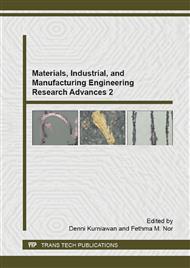[1]
K. Sockalingam and H. Z. Abdullah, Extraction of gelatin from black tilapia (Oreochromis mossambicus) head bones, Malay. J. Micro. 10 (2014) 71-76.
DOI: 10.1063/1.4919214
Google Scholar
[2]
[FAO] The States of World Fisheries and Aquaculture Food and Agriculture Organisation, Food and Agriculture Organization of the United Nations, Rome, (2012).
DOI: 10.18356/0170ea0f-en
Google Scholar
[3]
P. Kittiphattanabawon, S. Benjakul, W. Visessanguan, T. Nagai, and M. Tanaka, Characterisation of acid-soluble collagen from skin and bone of bigeye snapper (Priacanthus tayenus), Food Chem. 89 (2005) 363-372.
DOI: 10.1016/j.foodchem.2004.02.042
Google Scholar
[4]
S. S. Choi, and J. Regenstein, Physicochemical and sensory characteristics of fish gelatin, Food Chem. Toxic. 65 (2000) 194-199.
DOI: 10.1111/j.1365-2621.2000.tb15978.x
Google Scholar
[5]
V. Ferraro, A. P. Carvalho, C. Piccirillo, M. M. Santos, P. M. L. Castro, and M. E. Pintado, Extraction of high added value biological compounds from sardine, sardine-type fish and mackerel canning residues-A review, Mater. Sci. Eng. 33 (2013).
DOI: 10.1016/j.msec.2013.04.003
Google Scholar
[6]
Z. Khiari, D. Rico, A. B. Martin-Diana, and C. Barry-Ryan, Comparison between gelatines extracted from mackerel and blue whiting bones after different pre-treatments, Food Chem. 139 (2013) 347-354.
DOI: 10.1016/j.foodchem.2013.01.017
Google Scholar
[7]
A. A. Karim and R. Bhat, Fish gelatin: properties, challenges, and prospects as an alternative to mammalian gelatins, Food Hydrocolloids. 23 (2009) 563-576.
DOI: 10.1016/j.foodhyd.2008.07.002
Google Scholar
[8]
S. Wangtueai and A. Noomhorm, Processing optimization and characterization of gelatin from lizardfish (Saurida spp. ) scales, LWT - Food Sci. Tech. 42 (2009) 825-834.
DOI: 10.1016/j.lwt.2008.11.014
Google Scholar
[9]
F. A. de Wolf, Collagen and gelatin, in: W. Y. Aalbersberg, R. J. Hamer, P. Jasperse, H. H. J. de Jongh, C. G. Kruif, P. Walstra, and F. A. de Wolf (Eds. ), Industrial Proteins in Perspective (Progress in Biotechnology), Elseveir Sciences, 23, Chapter V, 2003, pp.133-218.
DOI: 10.1016/s0921-0423(03)80005-9
Google Scholar
[10]
H. Mori, Y. Tone, K. Shimizu, K. Zikihara, S. Tokutomi, T. Ida, and M. Hara, Studies on fish scale collagen of Pacific saury (Cololabis saira), Mater. Sci. Eng. 33 (2013) 174-181.
DOI: 10.1016/j.msec.2012.08.025
Google Scholar
[11]
K. Sockalingam and H. Z. Abdullah, Extraction and characterization of gelatin biopolymer from black tilapia (Oreochromis mossambicus) scales, Malay. J. Micro. 10 (2014) 132-137.
DOI: 10.1063/1.4919191
Google Scholar
[12]
M. Holá, J. Kalvoda, H. Nováková, R. Škoda, and V. Kanický, Possibilities of LA-ICP-MS technique for the spatial elemental analysis of the recent fish scales: Line scan vs. depth profiling, Appl. Surf. Sci. 257 (2011) 1932–(1940).
DOI: 10.1016/j.apsusc.2010.09.029
Google Scholar
[13]
Y. Wang and J. M. Regenstein, Effect of EDTA, HCl, and citric acid on Ca salt removal from Asian (silver) carp scales prior to gelatin extraction, J. Food Sci., 74 (2009) C426-C431.
DOI: 10.1111/j.1750-3841.2009.01202.x
Google Scholar
[14]
T. Ikoma, H. Kobayashi, J. Tanaka, D. Walsh, and S. Mann, Microstructure, mechanical, and biomimetic properties of fish scales from Pagrus major, J. Struct. Bio. 142 (2003) 327-333.
DOI: 10.1016/s1047-8477(03)00053-4
Google Scholar


